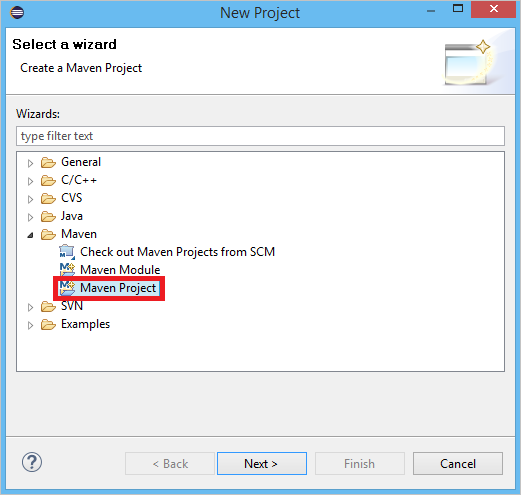快速入門:使用 Apache Storm 從事件中樞接收事件
Apache Storm 是分散式即時運算系統,可簡化未繫結資料串流的可靠處理。 本節說明如何使用「Azure 事件中樞」Storm Spout 來接收來自「事件中樞」的事件。 使用 Apache Storm,您可以將事件分割到多個裝載於不同節點的處理序。 事件中心與 Storm 的整合透過使用 Storm 的 Zookeeper 安裝透明地設定檢查點以檢查其進度、管理持續檢查點以及來自事件中心的平行接收,以簡化事件的使用。
如需事件中樞接收模式的詳細資訊,請參閱 事件中樞概觀。
必要條件
在開始進行本快速入門之前,您必須先建立事件中樞命名空間和事件中樞。 請使用 Azure 入口網站建立「事件中樞」類型的命名空間,然後取得您的應用程式與「事件中樞」進行通訊所需的管理認證。 若要建立命名空間和事件中樞,請依照這篇文章中的程序操作。
建立專案並新增程式碼
使用下列命令將封裝安裝到本機 Maven 存放區。 這樣可讓您在稍後的步驟中將它加入 Storm 專案中做為參考。
mvn install:install-file -Dfile=target\eventhubs-storm-spout-0.9-jar-with-dependencies.jar -DgroupId=com.microsoft.eventhubs -DartifactId=eventhubs-storm-spout -Dversion=0.9 -Dpackaging=jar在 Eclipse 中,建立新的 Maven 專案 (依序按一下 [檔案]、[新增]、[專案])。

選取 [使用預設工作區位置],然後按 [下一步]。
選取 [maven-archetype-quickstart] 原型,然後按 [下一步]。
插入 GroupId 和 ArtifactId,然後按一下 [完成]。
在 pom.xml 中,於
<dependency>節點中新增下列相依性。<dependency> <groupId>org.apache.storm</groupId> <artifactId>storm-core</artifactId> <version>0.9.2-incubating</version> <scope>provided</scope> </dependency> <dependency> <groupId>com.microsoft.eventhubs</groupId> <artifactId>eventhubs-storm-spout</artifactId> <version>0.9</version> </dependency> <dependency> <groupId>com.netflix.curator</groupId> <artifactId>curator-framework</artifactId> <version>1.3.3</version> <exclusions> <exclusion> <groupId>log4j</groupId> <artifactId>log4j</artifactId> </exclusion> <exclusion> <groupId>org.slf4j</groupId> <artifactId>slf4j-log4j12</artifactId> </exclusion> </exclusions> <scope>provided</scope> </dependency>在 src 資料夾中,建立名為 Config.properties 的檔案,複製下列內容,並取代
receive rule key與event hub name的值:eventhubspout.username = ReceiveRule eventhubspout.password = {receive rule key} eventhubspout.namespace = ioteventhub-ns eventhubspout.entitypath = {event hub name} eventhubspout.partitions.count = 16 # if not provided, will use storm's zookeeper settings # zookeeper.connectionstring=localhost:2181 eventhubspout.checkpoint.interval = 10 eventhub.receiver.credits = 10eventhub.receiver.credits 的值可決定批次處理多少事件之後,才將它們釋放到 Storm 管線。 為了簡單起見,此範例會將此值設定為 10。 在生產環境中,它通常應設定為較高的值。例如,1024年。 1 . 使用下列程式碼,建立稱為 LoggerBolt 的新類別:
import java.util.Map; import org.slf4j.Logger; import org.slf4j.LoggerFactory; import backtype.storm.task.OutputCollector; import backtype.storm.task.TopologyContext; import backtype.storm.topology.OutputFieldsDeclarer; import backtype.storm.topology.base.BaseRichBolt; import backtype.storm.tuple.Tuple; public class LoggerBolt extends BaseRichBolt { private OutputCollector collector; private static final Logger logger = LoggerFactory .getLogger(LoggerBolt.class); @Override public void execute(Tuple tuple) { String value = tuple.getString(0); logger.info("Tuple value: " + value); collector.ack(tuple); } @Override public void prepare(Map map, TopologyContext context, OutputCollector collector) { this.collector = collector; this.count = 0; } @Override public void declareOutputFields(OutputFieldsDeclarer declarer) { // no output fields } }此 Storm Bolt 會記錄已接收事件的內容。 這可以輕鬆地擴充以將 Tuple 儲存至儲存體服務。 採用事件中樞的 HDInsight Storm 範例 使用此相同方法將資料儲存到 Azure 儲存體和 Power BI 中。
使用下列程式碼,建立稱為 LogTopology 的類別:
import java.io.FileReader; import java.util.Properties; import backtype.storm.Config; import backtype.storm.LocalCluster; import backtype.storm.StormSubmitter; import backtype.storm.generated.StormTopology; import backtype.storm.topology.TopologyBuilder; import com.microsoft.eventhubs.samples.EventCount; import com.microsoft.eventhubs.spout.EventHubSpout; import com.microsoft.eventhubs.spout.EventHubSpoutConfig; public class LogTopology { protected EventHubSpoutConfig spoutConfig; protected int numWorkers; protected void readEHConfig(String[] args) throws Exception { Properties properties = new Properties(); if (args.length > 1) { properties.load(new FileReader(args[1])); } else { properties.load(EventCount.class.getClassLoader() .getResourceAsStream("Config.properties")); } String username = properties.getProperty("eventhubspout.username"); String password = properties.getProperty("eventhubspout.password"); String namespaceName = properties .getProperty("eventhubspout.namespace"); String entityPath = properties.getProperty("eventhubspout.entitypath"); String zkEndpointAddress = properties .getProperty("zookeeper.connectionstring"); // opt int partitionCount = Integer.parseInt(properties .getProperty("eventhubspout.partitions.count")); int checkpointIntervalInSeconds = Integer.parseInt(properties .getProperty("eventhubspout.checkpoint.interval")); int receiverCredits = Integer.parseInt(properties .getProperty("eventhub.receiver.credits")); // prefetch count // (opt) System.out.println("Eventhub spout config: "); System.out.println(" partition count: " + partitionCount); System.out.println(" checkpoint interval: " + checkpointIntervalInSeconds); System.out.println(" receiver credits: " + receiverCredits); spoutConfig = new EventHubSpoutConfig(username, password, namespaceName, entityPath, partitionCount, zkEndpointAddress, checkpointIntervalInSeconds, receiverCredits); // set the number of workers to be the same as partition number. // the idea is to have a spout and a logger bolt co-exist in one // worker to avoid shuffling messages across workers in storm cluster. numWorkers = spoutConfig.getPartitionCount(); if (args.length > 0) { // set topology name so that sample Trident topology can use it as // stream name. spoutConfig.setTopologyName(args[0]); } } protected StormTopology buildTopology() { TopologyBuilder topologyBuilder = new TopologyBuilder(); EventHubSpout eventHubSpout = new EventHubSpout(spoutConfig); topologyBuilder.setSpout("EventHubsSpout", eventHubSpout, spoutConfig.getPartitionCount()).setNumTasks( spoutConfig.getPartitionCount()); topologyBuilder .setBolt("LoggerBolt", new LoggerBolt(), spoutConfig.getPartitionCount()) .localOrShuffleGrouping("EventHubsSpout") .setNumTasks(spoutConfig.getPartitionCount()); return topologyBuilder.createTopology(); } protected void runScenario(String[] args) throws Exception { boolean runLocal = true; readEHConfig(args); StormTopology topology = buildTopology(); Config config = new Config(); config.setDebug(false); if (runLocal) { config.setMaxTaskParallelism(2); LocalCluster localCluster = new LocalCluster(); localCluster.submitTopology("test", config, topology); Thread.sleep(5000000); localCluster.shutdown(); } else { config.setNumWorkers(numWorkers); StormSubmitter.submitTopology(args[0], config, topology); } } public static void main(String[] args) throws Exception { LogTopology topology = new LogTopology(); topology.runScenario(args); } }這個類別會建立新的事件中樞 Spout,方法是使用組態檔中的屬性來進行具現化。 請務必注意此範例所建立的 Spout 工作數目會與事件中樞內的磁碟分割數目相同,這是為了發揮該事件中樞所允許的平行處理原則上限。
下一步
您可以造訪下列連結以深入了解事件中樞︰